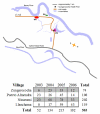Limited variation in vaccine candidate Plasmodium falciparum Merozoite Surface Protein-6 over multiple transmission seasons
- PMID: 20497564
- PMCID: PMC2881939
- DOI: 10.1186/1475-2875-9-138
Limited variation in vaccine candidate Plasmodium falciparum Merozoite Surface Protein-6 over multiple transmission seasons
Abstract
Background: Plasmodium falciparum Merozoite Surface Protein-6 (PfMSP6) is a component of the complex proteinacious coat that surrounds P. falciparum merozoites. This location, and the presence of anti-PfMSP6 antibodies in P. falciparum-exposed individuals, makes PfMSP6 a potential blood stage vaccine target. However, genetic diversity has proven to be a major hurdle for vaccines targeting other blood stage P. falciparum antigens, and few endemic field studies assessing PfMSP6 gene diversity have been conducted. This study follows PfMSP6 diversity in the Peruvian Amazon from 2003 to 2006 and is the first longitudinal assessment of PfMSP6 sequence dynamics.
Methods: Parasite DNA was extracted from 506 distinct P. falciparum infections spanning the transmission seasons from 2003 to 2006 as part of the Malaria Immunology and Genetics in the Amazon (MIGIA) cohort study near Iquitos, Peru. PfMSP6 was amplified from each sample using a nested PCR protocol, genotyped for allele class by agarose gel electrophoresis, and sequenced to detect diversity. Allele frequencies were analysed using JMP v.8.0.1.0 and correlated with clinical and epidemiological data collected as part of the MIGIA project.
Results: Both PfMSP6 allele classes, K1-like and 3D7-like, were detected at the study site, confirming that both are globally distributed. Allele frequencies varied significantly between transmission seasons, with 3D7-class alleles dominating and K1-class alleles nearly disappearing in 2005 and 2006. There was a significant association between allele class and village location (p-value = 0.0008), but no statistically significant association between allele class and age, sex, or symptom status. No intra-allele class sequence diversity was detected.
Conclusions: Both PfMSP6 allele classes are globally distributed, and this study shows that allele frequencies can fluctuate significantly between communities separated by only a few kilometres, and over time in the same community. By contrast, PfMSP6 was highly stable at the sequence level, with no SNPs detected in the 506 samples analysed. This limited diversity supports further investigation of PfMSP6 as a blood stage vaccine candidate, with the clear caveat that any such vaccine must either contain both alleles or generate cross-protective responses that react against both allele classes. Detailed immunoepidemiology studies are needed to establish the viability of these approaches before PfMSP6 advances further down the vaccine development pipeline.
Figures



Similar articles
-
Antibodies directed against merozoite surface protein-6 are induced by natural exposure to Plasmodium falciparum in a low transmission environment.Parasite Immunol. 2011 Jul;33(7):401-10. doi: 10.1111/j.1365-3024.2011.01299.x. Parasite Immunol. 2011. PMID: 21585398 Free PMC article.
-
Genetic diversity of the malaria vaccine candidate Plasmodium falciparum merozoite surface protein-3 in a hypoendemic transmission environment.Am J Trop Med Hyg. 2009 Mar;80(3):479-86. Am J Trop Med Hyg. 2009. PMID: 19270302 Free PMC article.
-
Geographical patterns of allelic diversity in the Plasmodium falciparum malaria-vaccine candidate, merozoite surface protein-2.Ann Trop Med Parasitol. 2001 Mar;95(2):117-32. doi: 10.1080/00034980120045833. Ann Trop Med Parasitol. 2001. PMID: 11299119
-
Limited antigenic diversity of Plasmodium falciparum apical membrane antigen 1 supports the development of effective multi-allele vaccines.BMC Med. 2014 Oct 16;12:183. doi: 10.1186/s12916-014-0183-5. BMC Med. 2014. PMID: 25319190 Free PMC article.
-
Can growth inhibition assays (GIA) predict blood-stage malaria vaccine efficacy?Hum Vaccin Immunother. 2012 Jun;8(6):706-14. doi: 10.4161/hv.19712. Epub 2012 Apr 20. Hum Vaccin Immunother. 2012. PMID: 22508415 Free PMC article. Review.
Cited by
-
Natural antibody response to Plasmodium falciparum merozoite antigens MSP5, MSP9 and EBA175 is associated to clinical protection in the Brazilian Amazon.BMC Infect Dis. 2013 Dec 28;13:608. doi: 10.1186/1471-2334-13-608. BMC Infect Dis. 2013. PMID: 24373342 Free PMC article.
-
Targeting plasmodium α-tubulin-1 to block malaria transmission to mosquitoes.Front Cell Infect Microbiol. 2023 Mar 16;13:1132647. doi: 10.3389/fcimb.2023.1132647. eCollection 2023. Front Cell Infect Microbiol. 2023. PMID: 37009496 Free PMC article.
-
Sexual recombination is a signature of a persisting malaria epidemic in Peru.Malar J. 2011 Oct 31;10:329. doi: 10.1186/1475-2875-10-329. Malar J. 2011. PMID: 22039962 Free PMC article.
-
Antibodies directed against merozoite surface protein-6 are induced by natural exposure to Plasmodium falciparum in a low transmission environment.Parasite Immunol. 2011 Jul;33(7):401-10. doi: 10.1111/j.1365-3024.2011.01299.x. Parasite Immunol. 2011. PMID: 21585398 Free PMC article.
References
-
- Gardner MJ, Hall N, Fung E, White O, Berriman M, Hyman RW, Carlton JM, Pain A, Nelson KE, Bowman S, Paulsen IT, James K, Eisen JA, Rutherford K, Salzberg SL, Craig A, Kyes S, Chan MS, Nene V, Shallom SJ, Suh B, Peterson J, Angiuoli S, Pertea M, Allen J, Selengut J, Haft D, Mather MW, Vaidya AB, Martin DM, Fairlamb AH, Fraunholz MJ, Roos DS, Ralph SA, McFadden GI, Cummings LM, Subramanian GM, Mungall C, Venter JC, Carucci DJ, Hoffman SL, Newbold C, Davis RW, Fraser CM, Barrell B. Genome sequence of the human malaria parasite Plasmodium falciparum. Nature. 2002;419:498–511. doi: 10.1038/nature01097. - DOI - PMC - PubMed
-
- Malaria Vaccine Technology Roadmap. http://www.malariavaccineroadmap.net
Publication types
MeSH terms
Substances
Grants and funding
LinkOut - more resources
Full Text Sources

